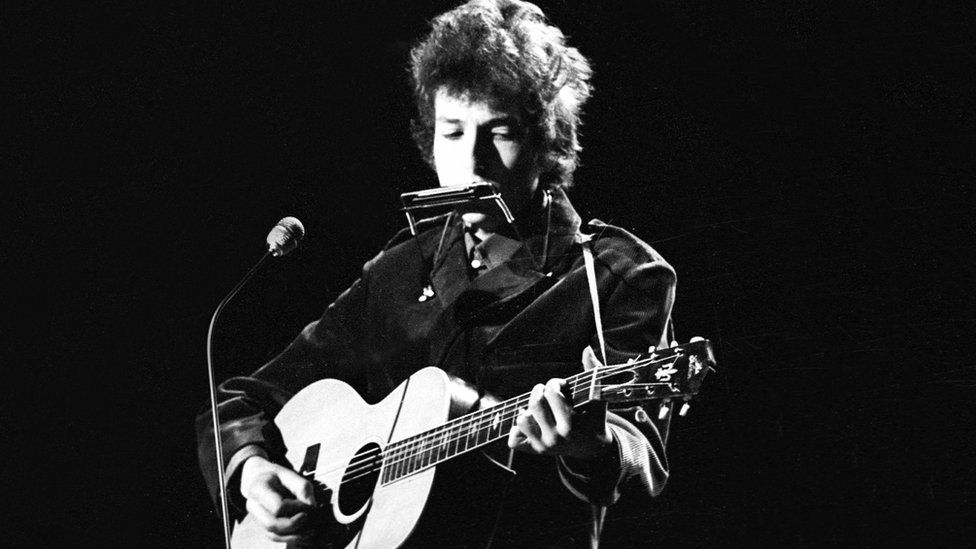
"I was so much older then / I'm younger than that now."
Bob Dylan sang those wise words at the tender age of 23, on his track My Back Pages.
As he reaches his 80th birthday on Monday, we've decided to ignore the advice of the famous Dylan documentary Don't Look Back and celebrate the life and career of the US singer-songwriter.
Be warned though before we get started, this list is about as long and exhaustive as some of the verses on his last album...

1. Bob Dylan is not his given birth name. But you already knew that, right? So here are 79 more facts about the artist formerly known as Robert Allan Zimmerman.
2. He has sold more than 125 million albums around the world.
3. Despite his success and cultural impact, Dylan has never had a number one single in the UK or US. For context, Mr Blobby, Crazy Frog and Las Ketchup have all topped the charts.
4. A poll of musicians, writers and academics, conducted on Dylan's 70th birthday, found his best song to be 1965's Like a Rolling Stone, which the singer once said was his most honest and direct work. "After that I wasn't interested in writing a novel or a play, he said. "I knew I wanted to write songs because it was just a whole new category."
5. Bruce Springsteen said the track, with its opening snare kick, sounded like "somebody kicked open the door to your mind". While another high-profile fan, U2's Bono, called it "a black eye of a pop song".
6. When asked what his songs were about, in a 1966 interview with Playboy magazine, Dylan quipped: "Some are about four minutes, some are about five, and some, believe it or not, are about eleven or twelve."
7. Surprisingly to many, the counterculture icon did not play at the 1969 Woodstock festival. Dylan was a Woodstock resident at the time (the festival was actually about 40 miles away) but he got a better offer - £35,000 to headline the Isle of Wight festival instead, with The Beatles watching on.
8. Speaking of The Fab Four... Dylan was the first man to introduce the band to marijuana, Sir Paul McCartney recently revealed to Uncut. 'We all ran into the backroom going, 'Give us a bit!'" said Sir Macca. "So that was the very first evening we ever got stoned!"
9. Many of his songs are more familiar to mainstream audiences as cover versions. For example Adele's version of Make You Feel My Love, The Byrds' Mr Tambourine Man and All Along The Watchtower by Jimi Hendrix. "He played [my songs] the way I would have done them if I was him," he said of the late guitarist. Dylan himself has recorded covers of Frank Sinatra and Paul Simon tunes.
10. Malibu resident Dylan has 17 houses around the world according to biographer Howard Sounes. One of them is reportedly in the Scottish Highlands.
11. The troubadour has won 10 Grammy awards, including three for his 1997 album Time Out of Mind, which many critics considered to be a return to form after a long artistic slump.
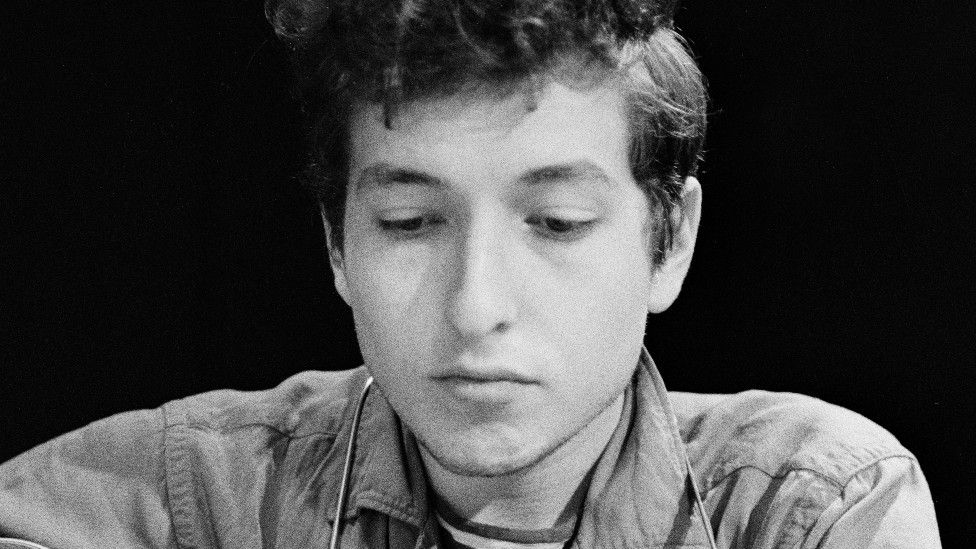
12. He was born into a Jewish family in Duluth, Minnesota, before moving upstate to Hibbing.
13. Country singer Hank Williams, and bluesmen Muddy Waters and John Lee Hooker were among his musical heroes growing up, along with the king of rock 'n' roll Elvis Presley. The Rebel Without a Cause James Dean was his celluloid hero.
14. Dylan saw Buddy Holly play live locally just a few days before he died in a plane crash.
15. As a youngster he played piano and guitar in several summer camp/high school bands. Their names included The Jokers, The Shadow Blasters, The Golden Chords and (our personal favourite) The Rock Boppers.
16. He wrote in his high school year book that it was his ambition "to join Little Richard".
17. Working as busboy in a Fargo restaurant, after finishing high school, remains the only normal job Dylan has ever done. But in another life he'd like to have been a soldier. In his 2004 memoir Chronicles he wrote he'd always pictured himself "dying in some heroic battle rather than a bed".
18. After moving to Minneapolis to study he turned his attention to folk music, swapping his electric guitar for an acoustic, which he played in cafes around the city's bohemian Dinkytown area.
19. He became totally enchanted by US folk singers like Odetta and Woody Guthrie, who he would later visit in a psychiatric hospital in New Jersey and play his own songs to him.
20. His first original composition of any note was called Song for Woody, and he even began to sing and talk like the Oklahoma singer.
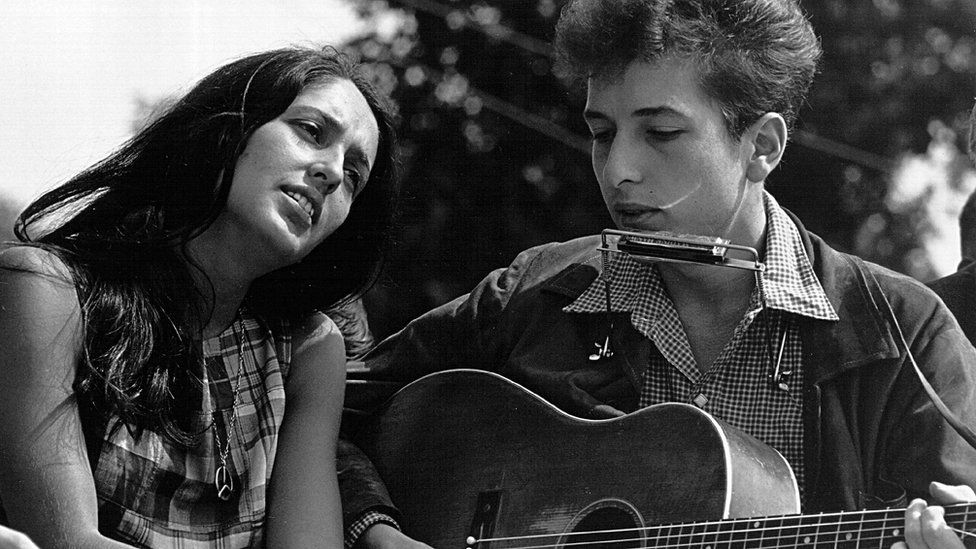
21. Guthrie offered Dylan his stash of unused lyrics but his young son Arlo was unable to find them when Dylan came knocking. Almost 40 years later, the lyrics were put to music by Essex folksinger Billy Bragg and Chicago band Wilco.
22. In his book, Dylan revealed that aside from Guthrie, blues legend Robert Johnson and Pirate Jenny - a song from Brecht/Weill play with music, The Threepenny Opera - were the biggest influences on his songwriting.
23. Having briefly operated under the name Elston Gunn, including while playing in Bobby Vee's band, Dylan then settled on his now famous moniker - a nod to the Welsh poet Dylan Thomas.
24. Dylan was a university drop-out. He never did finish his Liberal Arts degree at the University of Minnesota.
25. He read works by French symbolist poets like Arthur Rimbaud and American beat writers like Jack Kerouac. The One the Road writer's spontaneous style "blew a hole in my head", Dylan once remarked.
26. He moved to New York in 1961, to chase his dream of becoming a big music star.
27. He would regularly perform at venues in Greenwich Village such as Cafe Wha? and The Gaslight Cafe, where performers would pass around a basket at the end of each set and hope to be paid. Dylan once said he would get a dollar and cheeseburger to play his harmonica all afternoon alongside another singer in the village.
28. After nine months in The Big Apple he secured a deal with Colombia Records, feeding the company's PR executives "pure hokum", as he later put it.
29. His first trip abroad involved an eight-week stay in a freezing cold London in the winter of 1962/63, where he learned traditional English folk songs like Scarborough Fair, and (for contractual reasons) cut an LP under the pseudonym Billy Boy Grunt.
30. Early on in his career, he would make up tales about his background, telling journalists and radio presenters that he was an orphan, from New Mexico and that he used to travel with a carnival.
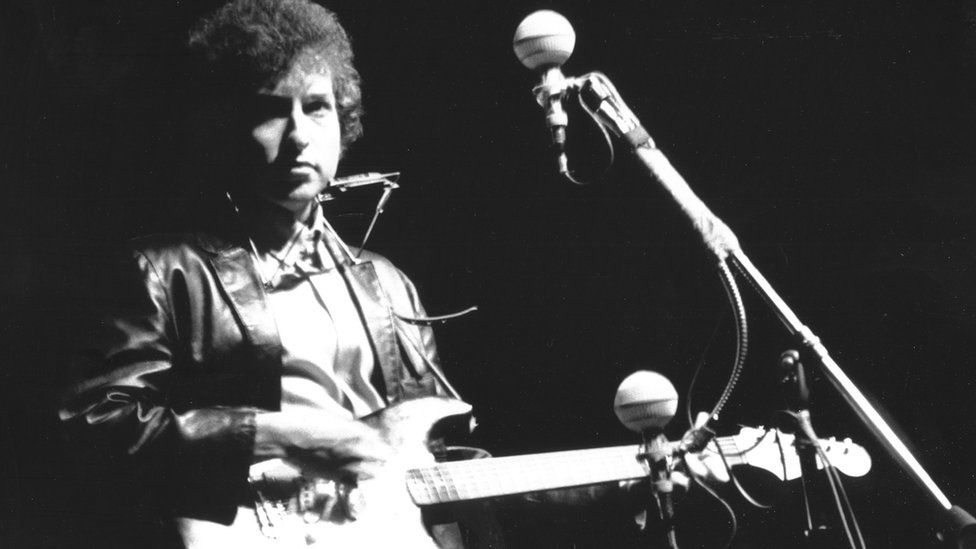
31. His self-titled debut album consisted largely of covers of traditional folk and blues numbers, such as The House of the Rising Sun.
32. His breakthrough follow-up, The Freewheelin' Bob Dylan, carried a picture of him and his girlfriend at the time, Suze Rotolo, on the cover. A performance of the song Don't Think Twice, It's Alright is believe to have signalled the end of the couple's relationship.
33. Blowin' in the Wind, the opening track on the album, was the song that made Dylan famous - initially thanks to the Peter, Paul and Mary version - and it also forever aligned with him the civil rights movement and anti-war protests.
34. The song has a similar melody to that of the African American spiritual song No More Auction Block. It came about as musician Agnes 'Sis' Cunningham urged artists like Dylan to put contemporary activist lyrics to old tunes which she then published in her Broadside magazine.
35. Dylan performed the number near to Dr Martin Luther King Jr at a march on Washington DC in 1963, becoming the voice of a generation in the process - a label he always rejected.
36. He said that Dr King's famous I Have a Dream speech that day affected him "in a profound way".
37. At the 1965 Newport Folk Festival, Dylan shocked fans and the music world by plugging in and rocking out, backed by a band that had been hastily-arranged the night before.
38. For the next year or so on tour around the world, Dylan and his band The Hawks were regularly booed when they went electric - including at London's Royal Albert Hall. He was famously even called "Judas" by one gig-goer in Manchester. "I don't believe you," replied Dylan. "You're lying".
39. The period that followed - with his trilogy of more abstract and surrealist bluesy folk rock albums, Bringing it All Back Home, Highway 61 Revisited and Blonde on Blonde - saw Dylan turn pop music into an art form, according to Sean Latham, director of the Institute for Bob Dylan Studies at the University of Tulsa.
Speaking on Radio 4's documentary series, It Ain't Me Your Looking For Babe: Bob Dylan at 80, Mr Latham said: "The closest parallels we can draw in fact are not to other pop stars but to say Picasso or James Joyce," he said.
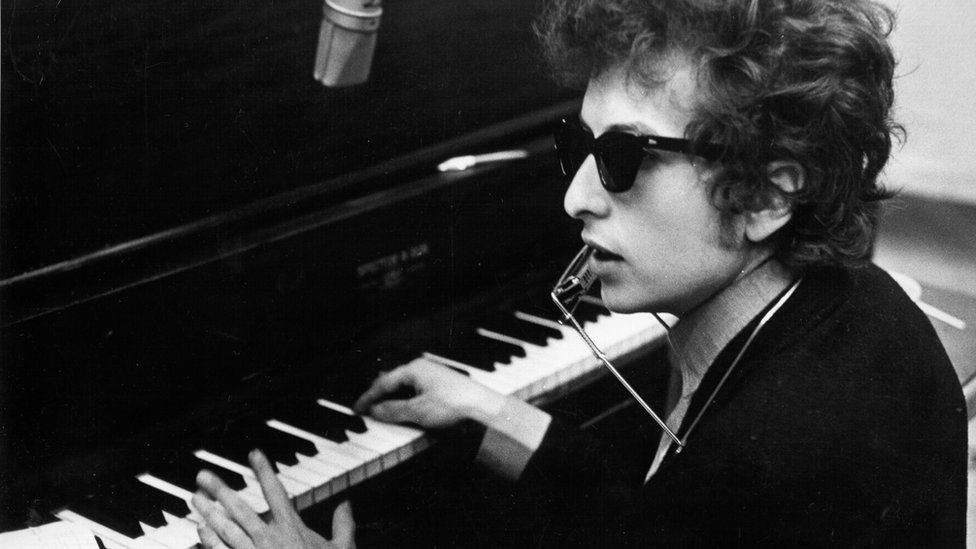
40. Dylan married Sara Lownds, who had worked as a model, in secret in 1965, and they had four children together. He also adopted her daughter from a prior marriage.
41. For a short while they lived at the famous Chelsea Hotel in New York.
42. One of their sons, Jakob, became known as the frontman of the 1990s band The Wallfowers.
43. Dylan did a screen test at Andy Warhol's studio, aka The Factory, and walked away with a print of an Elvis portrait.
44. He was injured in a mysterious motorbike accident in July 1966.
45. The singer then stopped touring and became a bit of a recluse for most of the rest of the 60s, living in a remote artists' colony in Woodstock, upstate New York. "Truth was that I wanted to get out of the rat race," he wrote in Chronicles. "Having children changed my life and segregated me from just about everybody and everything that was going on."
46. During this period he would paint, read the bible and jam with his with 1966 touring bandmates - who would become affectionately known as The Band. The collection of historical ballads and traditional songs they recorded were released many years later under the name The Basement Tapes.
47. The Band's star-studded final gig, which featured Dylan, was later the subject of a Martin Scorsese documentary entitled The Last Waltz.
48. Fans broke into Dylan's property (and bed), and he eventually moved back to Greenwich Village, where he was similarly hounded by Dylanologists.
49. The star rarely read the contracts he signed early on, and as a result he and his long-trusted manager Albert Grossman ended up suing each other in the 1980s.
50. Re-inventing himself again as a country singer, he wrote Wanted Man with Johnny Cash. Cash debuted the track live at San Quentin prison in 1969.
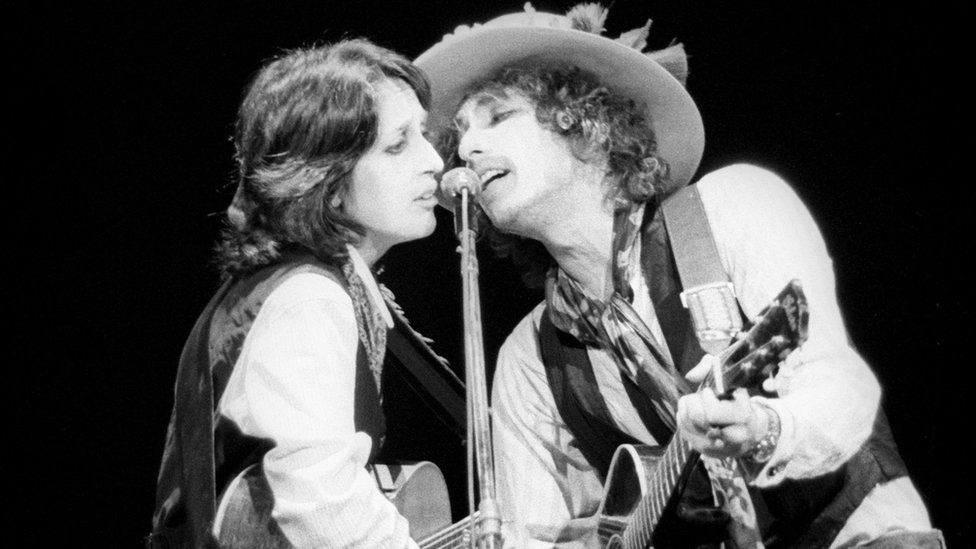
51. His 1975 album Blood on the Tracks tackled the topic of his separation from Sara.
52. Its opening track Tangled Up in Blue saw him experiment with timeless painting-style techniques in the muddled narrative of the song. The singer said it took "ten years to live and two years to write".
53. Dylan returned to the live circuit in 1974, playing arenas with The Band - one of the first major tours of its kind.
54. The following year he gathered a collection of entertainers - including beat poet Allen Ginsberg, singers Joan Baez, Joni Mitchell, Ramblin' Jack Elliott, and violinist Scarlet Rivera - for a travelling circus-esque US tour called the The Rolling Thunder Revue. Dylan even drove his own motor home for the circuit of small town venues, which was mythologised in a Scorsese Netflix film.
The finale of the first leg of the tour constituted a benefit concert for imprisoned boxer Ruben Carter - the subject of Dylan's recent song The Hurricane.
55. At times during the unique tour, Dylan painted his face white and wore a mask, while former girlfriend Baez dressed up as him.
56. Baez has stated that the lyrics to her song Diamonds and Rust relate to her relationship with her fellow singer.
57. He started to re-imagine his songs at this time, reworking the tempos and styles so they were almost unrecognisable. A decade later, after sustaining a debilitating hand injury, Dylan said a jazz singer inspired him to play and sing his songs using a totally different technique.
58. In 1978, Dylan released a cubist-inspired film he had written and directed during The Rolling Thunder Revue tour, called Renaldo and Clara. The almost four-hour long feature starred his (by-then ex) wife Sara and Baez, as The Woman in White, and it was an expensive flop at the box office.
59. Dylan had a period of Christian revelation in the late 1970s, following his divorce, after a fan threw a small silver cross on stage. He got baptised and released several albums containing contemporary gospel songs like Gotta Serve Somebody.
Speaking about his faith in 1997, however, the musician told Newsweek: "I find the religiosity and philosophy in the music, I don't find it anywhere else. I don't adhere to rabbis, preachers, evangelists all of that, I've learned more from the songs than I have from any of this entity."
60. Sporting a dangly earring, Dylan played a rather ragged rendition of Blowin' In the Wind at the global charity event Live Aid in 1985, backed by Rolling Stones guitarists Keith Richards and Ronnie Wood at Philadelphia's JFK Stadium.
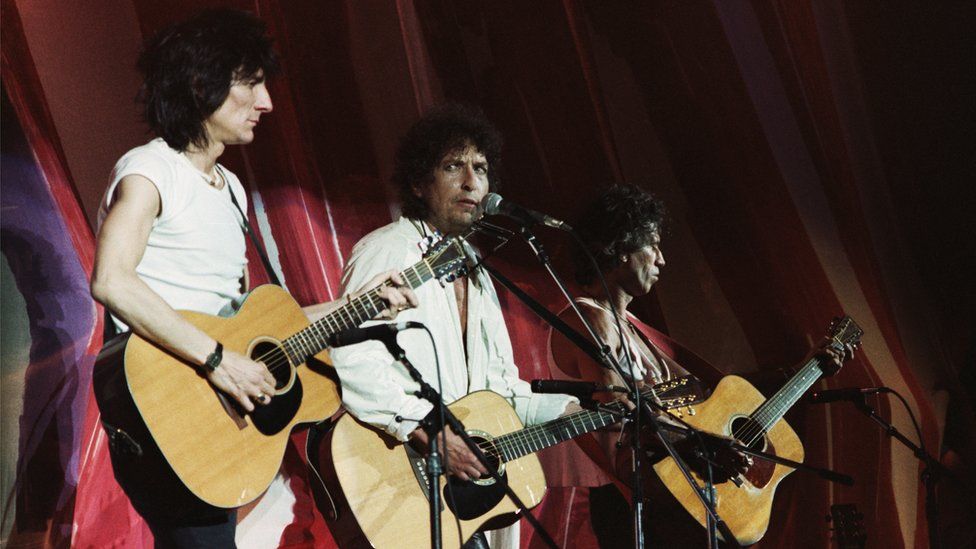
61. His song Blind Willie McTell, a tribute to the late bluesman, was released in 1991, oddly eight years after it was recorded.
62. Dylan married his backup singer Carolyn Dennis in 1986 and they had a daughter together, before divorcing in 1992. This second marriage remained a secret until Sounes' book, Down the Highway, was first published in 2001.
63. He formed a supergroup called The Traveling Wilburys in 1988, with his famous friends George Harrison, Tom Petty, Roy Orbison and Jeff Lynne. They each had band nicknames and Dylan was known as Lucky. Lucky Wilbury.
64. He was inducted into the The Rock and Roll Hall of Fame that year too.
65. His album Love and Theft was released on 11 September 2001 - the same day as the plane attacks on New York City.
66. Dylan won an Oscar and a Golden Globe award earlier that year for his track Things Have Changed, which featured in the Michael Douglas movie Wonder Boys.
67. He had his own weekly one-hour satellite radio show, Theme Time Radio Hour, from 2006 to 2009.
68. Dylan's name appears on the wall of Blackpool's Opera House, alongside other acts to have performed there, such as comedians Little and Large and Roy Chubby Brown.
69. He's a hip-hop fan. Dylan raved about Ice-T, Public Enemy, NWA and Run-DMC: "They were all poets and knew what was going on," he wrote. Some consider his own 1965 track Subterranean Homesick Blues to be one of the first modern rap songs.
70. Chronicles: Volume One (to give it its full title) was a New York times best-seller. However, critics claimed its author, Dylan, had cribbed certain passages from Marcel Proust, Mark Twain, Time magazine and even a guide to New Orleans.

71. The 2007 Dylan-inspired film I'm Not There became Heath Ledger's last movie to be released during the actor's lifetime.
72. A 160ft wide Dylan mural by Brazilian street artist Eduardo Kobra (pictured below) was unveiled in downtown Minneapolis in 2015.
73. Dylan was awarded the US Medal of Freedom in 2012 by then-Present Barack Obama; before receiving the Nobel Prize for Literature four years later, for having "created new poetic expressions within the great American song tradition". He became the first songwriter to win the prestigious award, but it was collected on his behalf by another - the priestess of punk Patti Smith, who nervously sang A Hard Rain's A-Gonna Fall.
74. He eventually delivered a Nobel lecture in the form of a spoken word piece with added piano tinkling and references to the plays of William Shakespeare and Homer's hero, Odysseus. "My songs are alive in the land of the living, but songs are unlike literature, they are meant to be sung and not read," he explained.
75. The last British gig of Dylan's so-called Never Ending Tour, which kicked off in 1988, saw him and Neil Young co-headline a UK show for the first time, at London's Hyde Park in 2019. He's played roughly 100 gigs a year for the last 20 years.
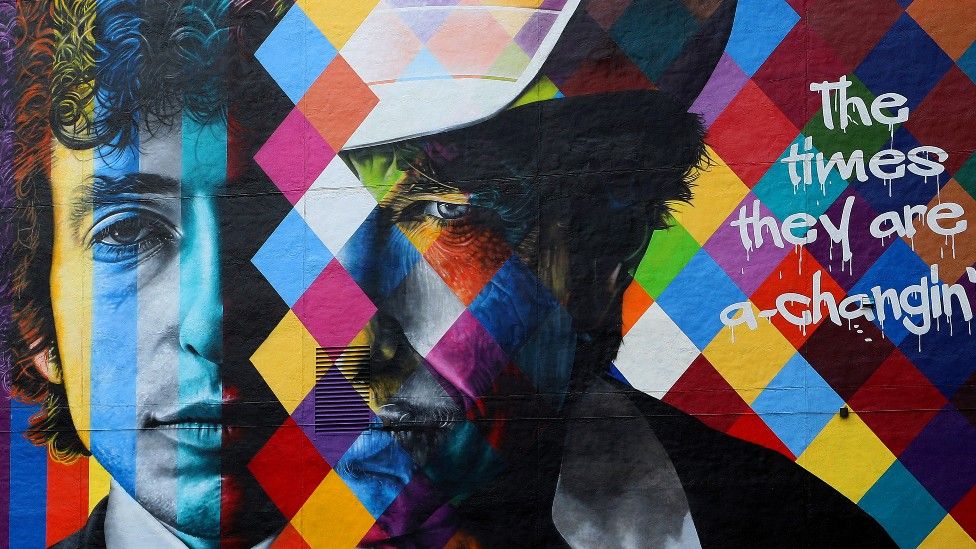
76. His first new song in eight years was released last year and it comprised of a 17-minute rumination on the 1960s and the assassination of JFK. It made Sad Eyed Lady of the Lowlands, his 11 minute-plus epic from 1966, seem pretty poppy by comparison.
77. In December, he sold the rights to his entire song catalogue to Universal Music Group (UMG) for an undisclosed fee. The New York Times claimed the deal could be worth more than $300m (£225m).
78. Dylan has been a keen painter and visual artist for decades and his work is currently on display and up for sale at the Castle Fine Art gallery in Manchester.
79. Last week, it emerged Dylan had agreed to become an honorary patron of the The Bob Willis Fund - a new charity in memory of the late England cricketer. "Bob Willis was a great sportsman who left too soon," Dylan noted. "I'm happy to help keep his flame and cause alive."
Willis told the BBC's John Wilson that he had changed his middle name to Dylan as a young man, in honour of his favourite musician.
80. The Bob Dylan Center in Tulsa, Oklahoma - a museum dedicated to artefacts from his huge archive - will open to the public in May next year.
So if you made it to the end of this list and are still craving more, now you know where to go for more Dylan facts.
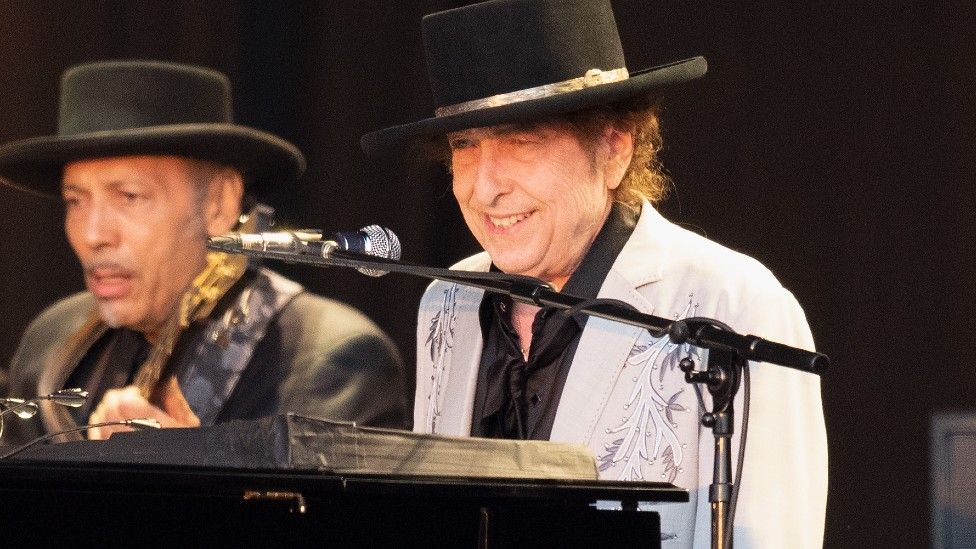
A series of BBC Radio 4 programmes about Bob Dylan, including It Ain't Me You're Looking For, Dinner With Dylan, and What's So Great About…Bob Dylan? are available now on BBC Sounds.
The 6 Music Artist Collection online also has programmes celebrating the singer.

Follow us on Facebook or on Twitter @BBCNewsEnts. If you have a story suggestion email entertainment.news@bbc.co.uk.
"about" - Google News
May 24, 2021 at 06:15AM
https://ift.tt/3fbXhkM
Bob Dylan: 80 things you may not know about him on his 80th birthday - BBC News
"about" - Google News
https://ift.tt/2MjBJUT
Bagikan Berita Ini















0 Response to "Bob Dylan: 80 things you may not know about him on his 80th birthday - BBC News"
Post a Comment